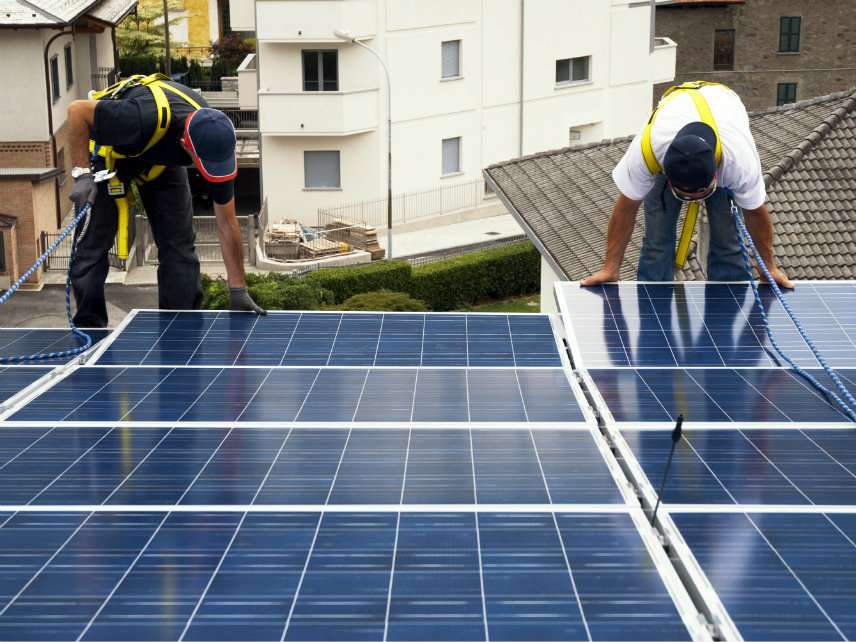California Regulators Want to Add $10,500 to the Price of a New Home With a Solar Panel Mandate
But they swear the new regulations will actually save homeowners money.

California regulators may achieve the remarkable feat of making housing in the Golden State even more expensive. All they have to do is pass a mandate that most new homes come with solar panels already installed.
The California Energy Commission is expected to vote today on regulations requiring all new single-family homes, as well as all multi-family buildings of three stories or less, to come pre-fabricated with solar panels. Exceptions would be made for smaller houses and for shade-covered roofs, whose owners could substitute other energy efficiency measures. The rules would take effect in January 2020.
By the commission's own estimates, this will increase the cost of the average new home by $10,500—in a state where the median home price already stands at roughly $529,460, according to the California Association of Realtors. The U.S. average, by comparison, is about $268,546.
Incredibly, the mandate's supporters are using the high cost of California housing to argue for the rule, by suggesting the new expenses will be relatively insignificant. The commission's analysis says the solar panel mandate will have "notably less impact on the housing market than 4–6 months of normal median family home price inflation." Oh…good.
Regulators also claim the costs won't matter because the mandate will actually save you money. The commission estimates that consumers will net $16,500 in savings over the span of 30 years.
"Their cash-flow position will be improved with the addition of solar. It won't make it worse," Andrew McAllister, one of the commission's five voting members, tells the San Francisco Chronicle.
Officials in St. Petersburg, Florida, made a similar argument when they were mulling their own solar mandate last year, with City Councilman Kevin Nurse telling Reason, "You can create a system that provides local jobs, reduces fossil fuel use and pollution, and reduces the cost of owning a home."
Sirens should start blaring in your head when officials justify regulations of consumers' behavior on the grounds that it will save them money.
Individual consumers are certainly fallible, but they usually are in the best position to make decisions about what expenses make sense for them. That they are not uniformly spending an extra $10,500 on solar panels—despite the massive government subsides flowing to the panels' makers and users—suggests they have other uses for that money.
They might, for instance, want to sink that money into a mutual fund, a 401k, or another investment that offers a better return than the estimated $16,500 over 30 years netted by solar panels. Others might place more value on spending that $10,500 today on a pressing necessity rather than putting it into some sort of state-mandated solar savings account.
Individuals face a lot of trade-offs with their money. Blithely assuming that some government-imposed saving measure is worth it for them is the height of arrogance.
Of course, the mandate isn't really being pushed to save consumers money. This is about the commission's "net-zero energy" goals of having all new homes give back to electric grid as much as they take from it.
As it happens, there are policy steps that would both reduce energy consumption and lower the cost of housing—and also give people more living options not fewer. Namely, repeal restrictive land use laws that exclusively zone whole swaths of California's cities for energy-hungry single-family homes, as opposed to more energy efficient multi-family homes and apartment buildings.
About 49 percent of San Francisco's housing stock is made up of single family homes. In Los Angeles it's 57 percent. In San Jose a full three-quarters of homes are detached single family units.
This is a problem for those interested in energy efficiency. According to a 2009 U.S. Energy Information Administration survey, households in multi-family buildings consumed roughly half the energy of a single-family households. Nationwide, single-family homes made up less than 70 percent of total housing units but were responsible for 80 percent of residential energy consumption.
The California legislature considered a bill this year that would have allowed for more energy-efficient, multi-family housing by upzoning residential plots near transit stops. The bill in question, SB 827, was quickly killed, in part by the opposition of environmental groups such as the Sierra Club, who argued that it would make development just a little too easy.
Instead, the Sierra Club has thrown its weight behind the solar panel mandate. For too many activists, government restrictions will always trump property rights when pursuing environmental goals.
Rent Free is a weekly newsletter from Christian Britschgi on urbanism and the fight for less regulation, more housing, more property rights, and more freedom in America's cities.



Show Comments (123)